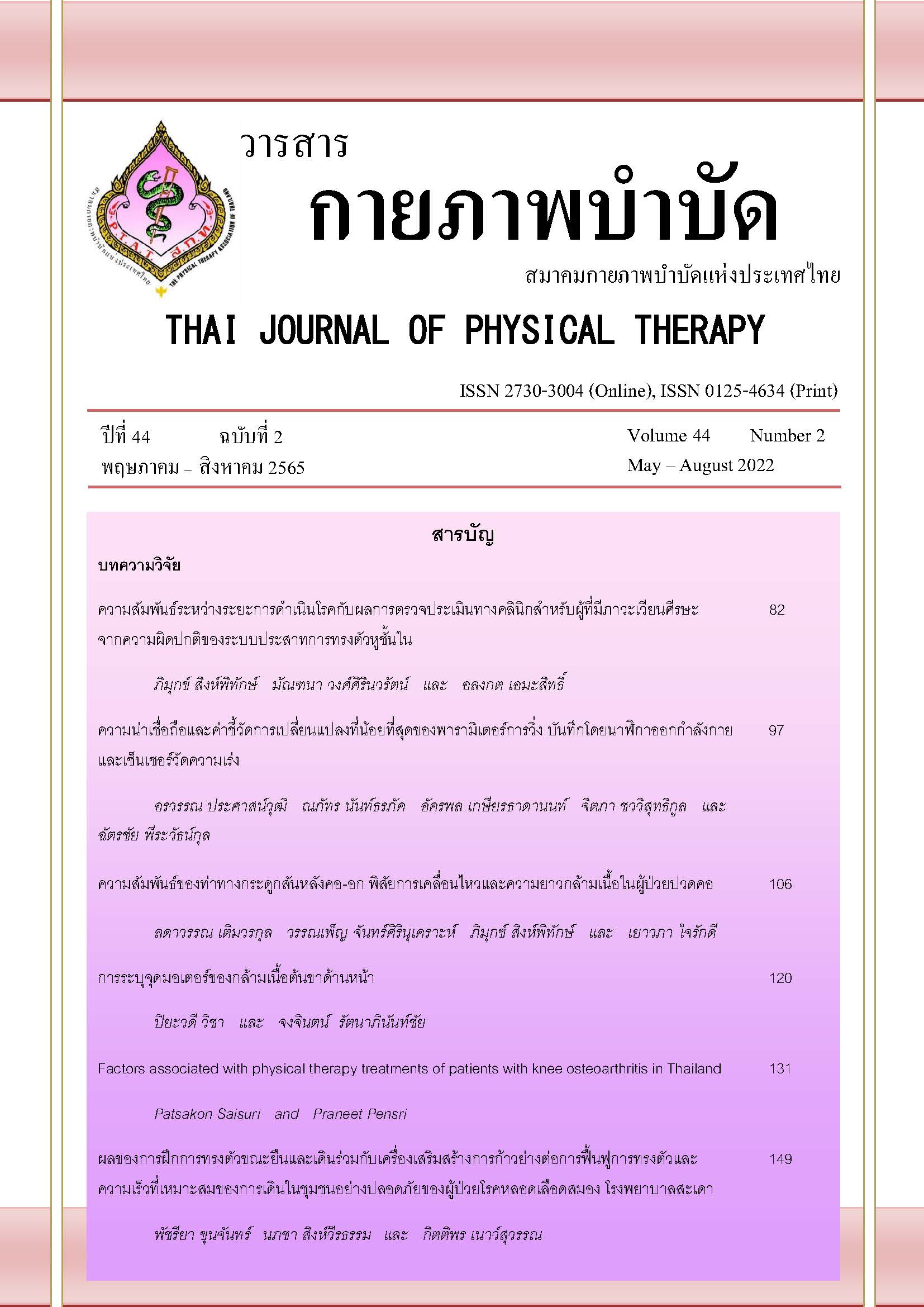ความสัมพันธ์ระหว่างระยะการดำเนินโรคกับผลการตรวจประเมินทางคลินิกสำหรับผู้ที่มีภาวะเวียนศีรษะจากความผิดปกติของระบบประสาทการทรงตัวหูชั้นใน
Main Article Content
บทคัดย่อ
ที่มาและความสำคัญ: อาการเวียนศีรษะเกิดได้จากหลายสาเหตุ รวมทั้งจากความผิดปกติของระบบประสาทการทรงตัวหูชั้นในที่มีพยาธิสภาพหลายแบบ ภายหลังระยะเฉียบพลัน ระบบประสาทการทรงตัวหูชั้นในสามารถฟื้นตัวได้เองทันทีหลังจากระบบประสาทการทรงตัวหูชั้นในเสียหาย ดังนั้น จึงเกิดข้อสงสัยว่า ผลการตรวจประเมินทางคลินิกที่นิยมใช้จะสัมพันธ์กับระยะเวลาหลังการเกิดอาการเวียนศีรษะหรือไม่
วัตถุประสงค์: เพื่อวิเคราะห์ความสัมพันธ์ของระยะเวลาการดำเนินโรคจำแนกเป็นกลุ่มเฉียบพลันและเรื้อรังกับผลการตรวจประเมินทางคลินิกในผู้ที่มีอาการเวียนศีรษะจากสาเหตุความผิดปกติของระบบประสาทการทรงตัวหูชั้นใน
วิธีการวิจัย: ผู้เข้าร่วมการวิจัยที่มีอาการเวียนศีรษะจำนวน 40 คน อายุ 18-79 ปี มีอาการครั้งแรกหรือมีอาการกำเริบครั้งสุดท้ายไม่เกิน 1 ปี ถูกจำแนกออกเป็นสองกลุ่ม คือ กลุ่มเฉียบพลัน (n=20) และกลุ่มเรื้อรัง (n=20) ทุกคนเข้ารับการตรวจประเมินทางคลินิก 6 วิธี ได้แก่ modified clinical test of sensory interaction on balance, gait with vertical head turns, gait and pivot turn, head impulse test, horizontal dynamic visual acuity test และ vertical dynamic visual acuity test และตรวจเพื่อยืนยันการวินิจฉัยว่ามีความผิดปกติของระบบประสาทการทรงตัวหูชั้นในด้วย battery vestibular diagnostic test ภายในวันเดียวกัน วิเคราะห์ความสัมพันธ์ระหว่างระยะเวลาการดำเนินโรคกับการพบผลผิดปกติด้วยการตรวจประเมินทางคลินิกทั้ง 6 วิธี
ผลการวิจัย: ไม่พบความสัมพันธ์อย่างมีนัยสำคัญทางสถิติระหว่างระยะการดำเนินโรคกับการพบผลผิดปกติด้วยวิธีการตรวจประเมินทางคลินิก นอกจากนั้นยังพบว่ากลุ่มเรื้อรังมีแนวโน้มพบความผิดปกติด้วยการตรวจประเมินทางคลินิกมากกว่ากลุ่มเฉียบพลัน
สรุปผล: ผู้ป่วยที่มีภาวะความผิดปกติของระบบประสาทการทรงตัวหูชั้นในเรื้อรังส่วนใหญ่ไม่สามารถปรับตัวหลังการเกิดพยาธิสภาพ ดังนั้น การตรวจประเมินทางคลินิกยังสามารถพบความผิดปกติของระบบประสาทการทรงตัวหูชั้นในได้แม้ว่าผู้ป่วยจะมีอาการมานานแล้วก็ตาม
Article Details

อนุญาตภายใต้เงื่อนไข Creative Commons Attribution-NonCommercial-NoDerivatives 4.0 International License.
เอกสารอ้างอิง
Herdman SJ, Clendaniel R. Vestibular rehabilitation: FA Davis; 2014.
Lacour M, Helmchen C, Vidal PP. Vestibular compensation: the neuro-otologist's best friend. J Neurol. 2016; 263 (Suppl 1): S54-64.
Lacour M, Barthelemy J, Borel L, Magnan J, Xerri C, Chays A, et al. Sensory strategies in human postural control before and after unilateral vestibular neurotomy. Exp Brain Res. 1997; 115 (2): 300-10.
Lacour M, Bernard-Demanze L. Interaction between Vestibular Compensation Mechanisms and Vestibular Rehabilitation Therapy: 10 Recommendations for Optimal Functional Recovery. Front Neurol. 2014; 5: 285.
Cohen HS. A review on screening tests for vestibular disorders. J Neurophysiol. 2019; 122 (1): 81-92.
Cohen HS, Mulavara AP, Peters BT, Sangi-Haghpeykar H, Bloomberg JJ. Standing balance tests for screening people with vestibular impairments. Laryngoscope. 2014; 124 (2): 545-50.
Matsuda PN, Taylor C, Shumway-Cook A. Examining the relationship between medical diagnoses and patterns of performance on the modified Dynamic Gait Index. Phys Ther. 2015; 95 (6): 854-63.
Wrisley DM, Marchetti GF, Kuharsky DK, Whitney SL. Reliability, internal consistency, and validity of data obtained with the functional gait assessment. Phys Ther. 2004; 84 (10): 906-18.
Schubert M, J Tusa R, E Grine L, Herdman S. Optimizing the Sensitivity of the Head Thrust Test for Identifying Vestibular Hypofunction 2004. 151-8 p.
Dannenbaum E, Paquet N, Chilingaryan G, Fung J. Clinical evaluation of dynamic visual acuity in subjects with unilateral vestibular hypofunction. Otology & Neurotology. 2009; 30 (3): 368-72.
Fife TD, Tusa RJ, Furman JM, Zee DS, Frohman E, Baloh RW, et al. Assessment: vestibular testing techniques in adults and children: report of the Therapeutics and Technology Assessment Subcommittee of the American Academy of Neurology. Neurology. 2000; 55 (10): 1431-41.
Jongkees LB, Philipszoon AJ. Electronystagmography. Acta Otolaryngol Suppl. 1964;189 (Suppl 189): 1+.
Young E, Fernandez C, Goldberg J. Responses of squirrel monkey vestibular neurons to audio-frequency sound and head vibration. Acta Otolaryngol. 1977; 84 (1-6): 352-60.
Iwasaki S, Chihara Y, Smulders Y, Burgess A, Halmagyi G, Curthoys I, et al. The role of the superior vestibular nerve in generating ocular vestibular-evoked myogenic potentials to bone conducted vibration at Fz. Clin Neurophysiol. 2009; 120 (3): 588-93.
Jariengprasert C, Tiensuwan M, Euasirirattanapaisan K. A comparison of vestibular evoked myogenic potential (VEMP) between definite Meniere's disease patients and normal healthy adults. J Med Assoc Thai. 2013; 96 (12):1563-8.
Becker-Bense S, Buchholz H-G, Best C, Schreckenberger M, Bartenstein P, Dieterich M. Vestibular compensation in acute unilateral medullary infarction: FDG-PET study. Neurology. 2013; 80 (12): 1103-9.
Cousins S, Cutfield NJ, Kaski D, Palla A, Seemungal BM, Golding JF, et al. Visual dependency and dizziness after vestibular neuritis. PLoS One. 2014; 9 (9): e105426.
Cutfield NJ, Scott G, Waldman AD, Sharp DJ, Bronstein AM. Visual and proprioceptive interaction in patients with bilateral vestibular loss. Neuroimage Clin. 2014; 4: 274-82.
Allum JHJ, Scheltinga A, Honegger F. The Effect of Peripheral Vestibular Recovery on Improvements in Vestibulo-ocular Reflexes and Balance Control After Acute Unilateral Peripheral Vestibular Loss. Otol Neurotol. 2017; 38 (10): e531-e8.
Halmagyi GM, Curthoys IS, Cremer PD, Henderson CJ, Todd MJ, Staples MJ, et al. The human horizontal vestibulo-ocular reflex in response to high-acceleration stimulation before and after unilateral vestibular neurectomy. Exp Brain Res. 1990; 81 (3): 479-90.
Schniepp R, Schlick C, Schenkel F, Pradhan C, Jahn K, Brandt T, et al. Clinical and neurophysiological risk factors for falls in patients with bilateral vestibulopathy. J Neurol. 2017; 264 (2): 277-83.
Raphan T, Imai T, Moore ST, Cohen B. Vestibular compensation and orientation during locomotion. Ann N Y Acad Sci. 2001; 942: 128-38.
Bronstein AM, Dieterich M. Long-term clinical outcome in vestibular neuritis. Curr Opin Neurol. 2019; 32 (1): 174-80.
Scheltinga A, Honegger F, Timmermans DP, Allum JH. The Effect of Age on Improvements in Vestibulo-Ocular Reflexes and Balance Control after Acute Unilateral Peripheral Vestibular Loss. Front Neurol. 2016; 7: 18.
Karapolat H, Celebisoy N, Kirazli Y, Ozgen G, Gode S, Gokcay F, et al. Is vestibular rehabilitation as effective in bilateral vestibular dysfunction as in unilateral vestibular dysfunction? Eur J Phys Rehabil Med. 2014; 50 (6): 657-63.
Herdman SJ, Hall CD, Maloney B, Knight S, Ebert M, Lowe J. Variables associated with outcome in patients with bilateral vestibular hypofunction: Preliminary study. J Vestib Res. 2015; 25 (3-4): 185-94.
Guinand N, Pijnenburg M, Janssen M, Kingma H. Visual acuity while walking and oscillopsia severity in healthy subjects and patients with unilateral and bilateral vestibular function loss. Arch Otolaryngol Head Neck Surg. 2012; 138 (3): 301-6.


